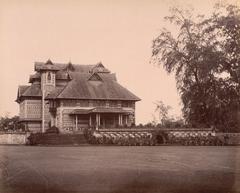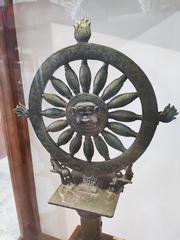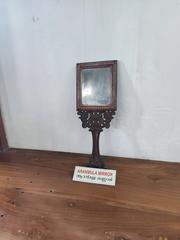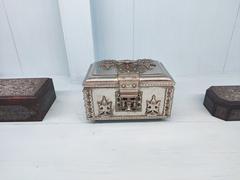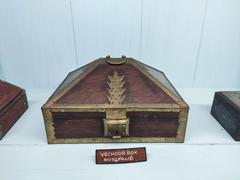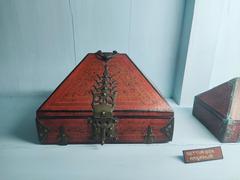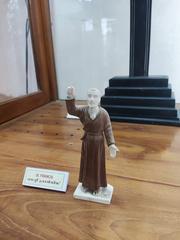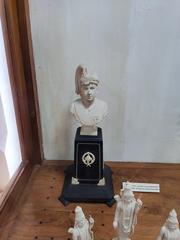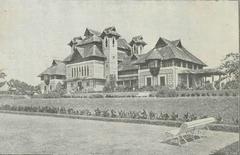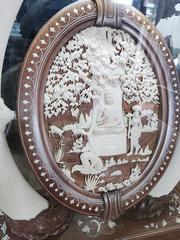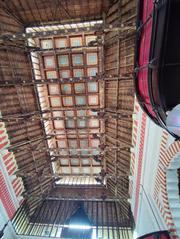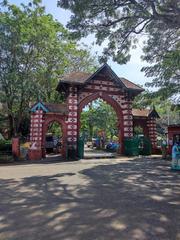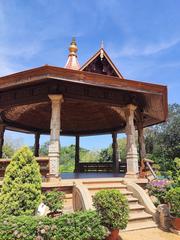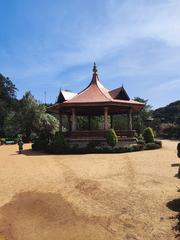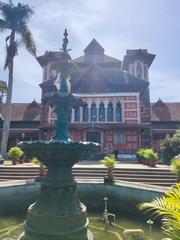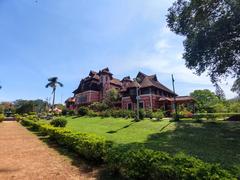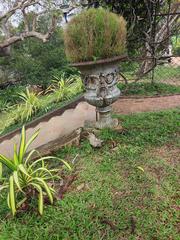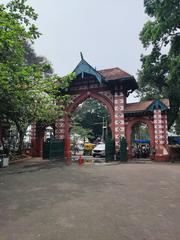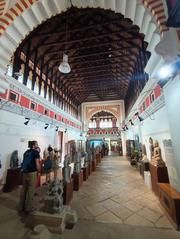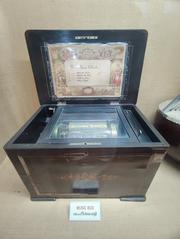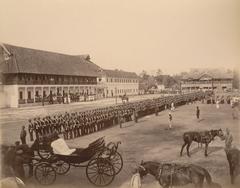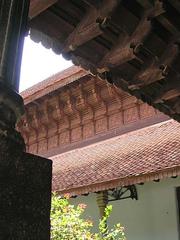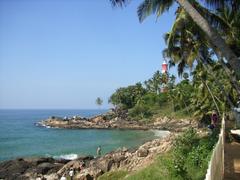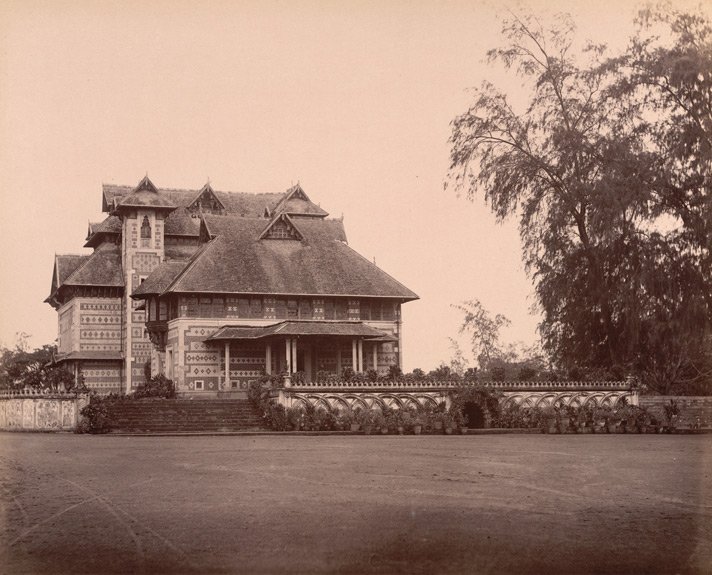
Visiting Hours and Tickets for Napier Museum Thiruvananthapuram
Date: 17/07/2024
Introduction to Napier Museum
The Napier Museum in Thiruvananthapuram, Kerala, stands as a beacon of the region’s rich cultural and historical heritage. Established in 1855 and named after Lord Napier, the then Governor of Madras, the museum provides a multifaceted exploration of Kerala’s artistic and historical treasures. The current building, completed in 1880, is a marvel of Indo-Saracenic architecture, designed by the British architect Robert Chisholm. This unique structure showcases a blend of Indian, Chinese, Kerala, and Mughal architectural styles (Kerala Tourism). The museum’s vast collection includes bronze idols, ancient ornaments, ivory carvings, and a temple chariot, which collectively offer a profound insight into the cultural and artistic heritage of Kerala (Kerala Museums).
Visitors to the Napier Museum can also appreciate its pioneering natural air conditioning system and the intricate woodwork and stained glass windows that adorn the building (Architectural Digest). Beyond its architectural beauty, the museum plays a pivotal role in education and research, serving as a resource center for students, historians, and researchers interested in Kerala’s cultural history. The museum regularly organizes workshops, seminars, and exhibitions to enhance public understanding and appreciation of the region’s heritage (Kerala State Department of Archaeology).
Whether you are a history enthusiast, an art lover, or a curious traveler, the Napier Museum offers a comprehensive cultural experience. This guide will provide detailed information on the museum’s history, collections, visiting hours, ticket prices, and travel tips to help you plan your visit effectively.
Napier Museum Table of Contents
- Introduction
- Historical Background
- Architectural Significance
- Cultural and Artistic Significance
- Historical Artifacts and Exhibits
- Visitor Information
- Visiting Hours
- Tickets
- Best Time to Visit
- Travel Tips and Nearby Attractions
- Accessibility
- Role in Education and Research
- Significance in Promoting Tourism
- Preservation and Conservation Efforts
- Community Engagement and Outreach
- Future Prospects and Developments
- FAQ
- Conclusion
Exploring Napier Museum - History, Visiting Hours, Tickets, and More
Historical Background
The Napier Museum, located in Thiruvananthapuram, Kerala, India, is a testament to the rich cultural and historical heritage of the region. Established in 1855, the museum was named after Lord Napier, the then Governor of Madras. The museum’s current building, designed by the British architect Robert Chisholm, was completed in 1880. This architectural marvel is a blend of Indian, Chinese, Kerala, and Mughal styles, making it a unique structure in the annals of museum architecture (Kerala Tourism).
Architectural Significance
The Napier Museum is renowned for its distinctive architectural style. The building is an exemplary model of Indo-Saracenic architecture, which combines traditional Indian architecture with Gothic revival and Neo-Classical styles. The use of red and white bricks, minarets, and gothic roofs, along with the intricate woodwork and stained glass windows, make it a visual delight. The natural air conditioning system, a pioneering feature at the time, ensures that the museum remains cool even during the hot summer months (Architectural Digest).
Cultural and Artistic Significance
The museum houses a vast collection of artifacts that reflect the cultural and artistic heritage of Kerala. The collection includes bronze idols, ancient ornaments, a temple chariot, and ivory carvings. One of the most notable exhibits is the life-size statue of Lord Vishnu, which dates back to the 8th century. The museum also boasts a rich collection of traditional Kerala lamps, which are an integral part of the state’s cultural and religious practices (Kerala Museums).
Historical Artifacts and Exhibits
The Napier Museum’s collection is a treasure trove of historical artifacts. The museum’s bronze collection is particularly noteworthy, featuring exquisite pieces from the Chola dynasty. These bronzes are celebrated for their intricate detailing and craftsmanship. The museum also houses a rare collection of ancient coins, which provide valuable insights into the economic history of the region. Additionally, the museum’s collection of ancient musical instruments offers a glimpse into the rich musical traditions of Kerala (Indian Museum Guide).
Visitor Information
Visiting Hours: The Napier Museum is open from 10:00 AM to 5:00 PM, Tuesday to Sunday. It remains closed on Mondays and national holidays.
Tickets: The entry fee is nominal, with different rates for adults, children, and foreign nationals. Special discounts are available for students and senior citizens.
Best Time to Visit: While the museum can be visited year-round, the best time to visit is during the cooler months from October to February.
Travel Tips and Nearby Attractions
When visiting the Napier Museum, consider exploring nearby attractions such as the Natural History Museum, the Sree Chitra Art Gallery, and the Thiruvananthapuram Zoo. These sites provide a comprehensive cultural and historical experience of the region.
Accessibility
The Napier Museum is committed to being accessible to all visitors. It offers wheelchair access, accessible restrooms, and other facilities to ensure a comfortable visit for people with disabilities.
Role in Education and Research
The Napier Museum plays a crucial role in the field of education and research. It serves as a resource center for students, researchers, and historians who are interested in the cultural and historical heritage of Kerala. The museum regularly organizes workshops, seminars, and exhibitions to promote awareness and understanding of the region’s rich heritage. The museum’s library, which houses a vast collection of books and manuscripts, is a valuable resource for researchers (Kerala State Department of Archaeology).
Significance in Promoting Tourism
The Napier Museum is one of the most popular tourist attractions in Thiruvananthapuram. Its unique architecture, coupled with its rich collection of artifacts, attracts thousands of visitors every year. The museum is part of the larger museum complex, which also includes the Natural History Museum and the Sree Chitra Art Gallery. This makes it a must-visit destination for tourists who are interested in exploring the cultural and historical heritage of Kerala (Incredible India).
Preservation and Conservation Efforts
The preservation and conservation of the artifacts housed in the Napier Museum are of paramount importance. The museum has implemented several measures to ensure the longevity of its collection. These include climate control systems, regular maintenance, and restoration of artifacts. The museum also collaborates with national and international organizations to adopt best practices in conservation. These efforts are crucial in preserving the cultural and historical heritage of Kerala for future generations (Conservation Journal).
Community Engagement and Outreach
The Napier Museum is actively involved in community engagement and outreach programs. The museum organizes educational programs for school children, aiming to instill a sense of pride and appreciation for their cultural heritage. The museum also collaborates with local artists and craftsmen to promote traditional arts and crafts. These initiatives not only help in preserving the cultural heritage but also provide a platform for local artists to showcase their talents (Cultural Heritage India).
Future Prospects and Developments
The Napier Museum is continuously evolving to meet the changing needs of its visitors. Plans are underway to digitize the museum’s collection, making it accessible to a global audience. The museum is also exploring the use of virtual reality and augmented reality to enhance the visitor experience. These initiatives are aimed at making the museum more interactive and engaging, thereby attracting a larger number of visitors (Museum Next).
FAQ
What are the visiting hours of the Napier Museum?
The museum is open from 10:00 AM to 5:00 PM, Tuesday to Sunday, and is closed on Mondays and national holidays.
How much are the tickets for the Napier Museum?
The ticket prices vary for adults, children, and foreign nationals, with discounts available for students and senior citizens.
What is the best time to visit the Napier Museum?
The best time to visit is during the cooler months from October to February.
Are there facilities for visitors with disabilities?
Yes, the museum offers wheelchair access, accessible restrooms, and other facilities for people with disabilities.
In conclusion, the Napier Museum is not just a repository of artifacts but a living institution that plays a vital role in preserving and promoting the cultural and historical heritage of Kerala. Its unique architecture, rich collection, and educational initiatives make it a significant landmark in Thiruvananthapuram.
Summary of Napier Museum Visit
In conclusion, the Napier Museum is more than just a repository of artifacts; it is a vibrant institution that plays a crucial role in preserving and promoting Kerala’s cultural and historical heritage. Its unique Indo-Saracenic architecture, coupled with its rich and diverse collection of artifacts, makes it a must-visit destination in Thiruvananthapuram. The museum’s efforts in education, research, and community engagement further underscore its significance in the cultural landscape of Kerala (Kerala State Department of Archaeology).
The museum’s commitment to accessibility and its ongoing preservation and conservation efforts ensure that it remains a welcoming and sustainable environment for all visitors. With plans to digitize its collection and incorporate virtual and augmented reality technologies, the Napier Museum is poised to offer an even more interactive and engaging experience for future generations (Museum Next).
Whether exploring the bronze idols from the Chola dynasty, the traditional Kerala lamps, or the contemporary art gallery, visitors are sure to leave with a deeper appreciation of Kerala’s rich cultural heritage. Don’t miss the opportunity to explore the Napier Museum and its surrounding attractions for a comprehensive cultural and historical experience (Incredible India).
Reliable Sources and References
- Kerala Tourism. (n.d.). https://www.keralatourism.org
- Architectural Digest. (n.d.). https://www.architecturaldigest.in
- Kerala Museums. (n.d.). https://www.keralamuseums.com
- Indian Museum Guide. (n.d.). https://www.indianmuseumguide.com
- Kerala State Department of Archaeology. (n.d.). https://www.keralaarchaeology.org
- Incredible India. (n.d.). https://www.incredibleindia.org
- Conservation Journal. (n.d.). https://www.conservationjournal.org
- Cultural Heritage India. (n.d.). https://www.culturalheritageindia.org
- Museum Next. (n.d.). https://www.museumnext.com
